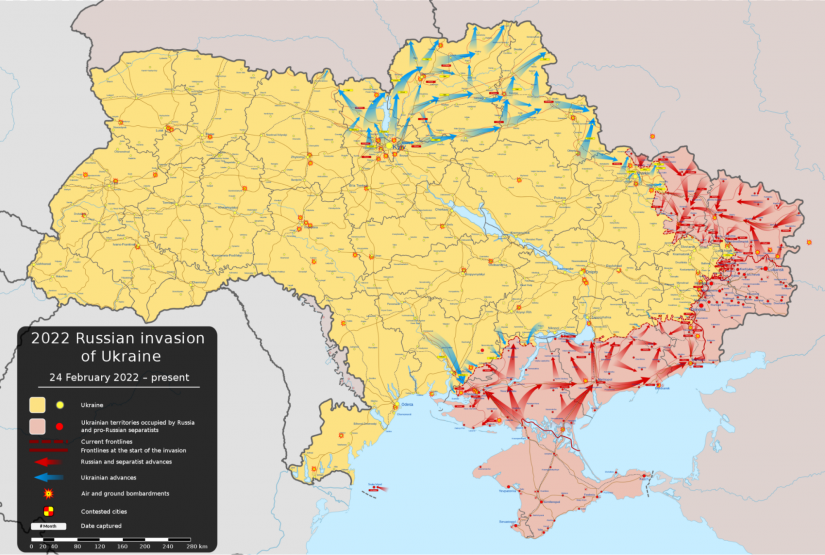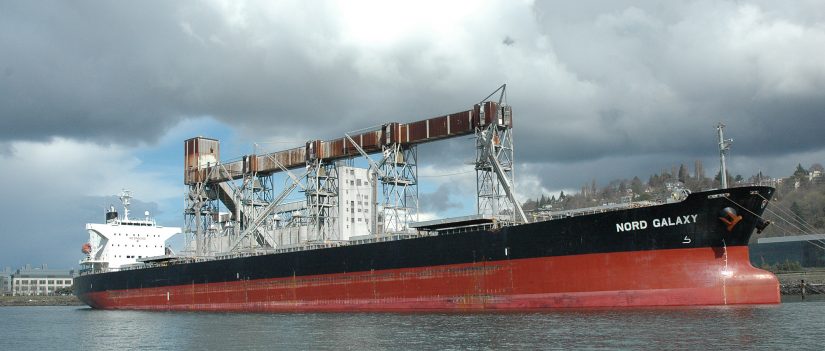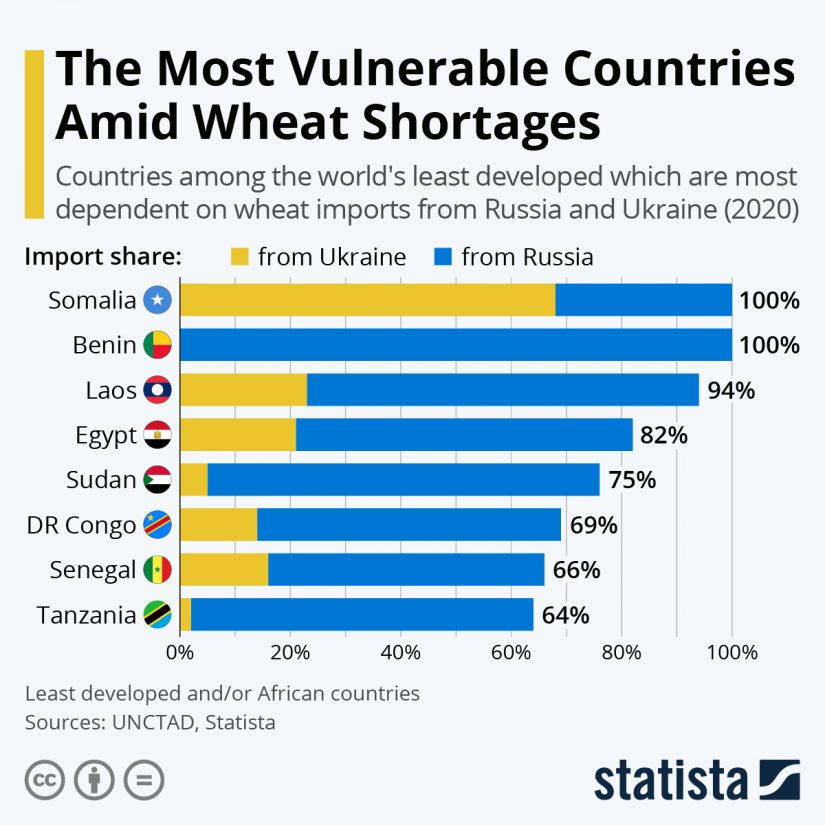Battle on the Black Sea: Maritime Implications of the Russo-Ukrainian War
At the time of this writing, the war in Ukraine is an ongoing conflict. This article attempts to capture the situation as accurately as possible with currently available information. It is a rapidly changing situation. This piece focuses on the maritime consequences and is not meant to minimize the tremendous cost paid by everyday people caught up in war.
“The Black Sea is, after all, where many of the world’s largest powers come together.”
– Maximilian Hess, a Central Asia fellow at the Foreign Policy Research Institute
War is destructive. War is deceptive. The maritime impacts of the Russo-Ukrainian conflict will likely take decades to be understood fully. The war has been going on since 2014, beginning with the invasion and annexation of Crimea, an area of strategic importance. The recent escalation of Russia’s invasion of Ukraine has captured international attention. In the past weeks, the stories have focused on the Battle for Kyiv, the collapse of the Russian advance, the Siege of Mariupol, and the stiff resistance of the Ukrainian forces in the Donbas. Overshadowed by the devastation on land, a looming humanitarian disaster caused by the war has received relatively less attention. The invasion has caused significant disruptions to major maritime trade routes, with serious implications for international shipping and the global supply chain, especially wheat exports to developing nations. In the opening hours of the recent invasion, a small but vocal community of maritime journalists, policy analysts, and supply chain experts made the argument that this could happen. Until recently, the international press has been mostly silent on the issue. While talks to rectify the situation are advancing, why has this issue not been more widely reported?
In the 21st century, it can be hard to imagine a war taking place for access to the sea, but the current conflict suggests cutting Ukraine off from the sea may be a goal of the Russian campaign. Understandably Ukrainian forces have been fighting tooth and nail to avoid that outcome. The human toll of the war has already been considerable and rightfully the focus has been on the land battles. From a marine perspective, the war foreshadows even bleaker impacts that extend well beyond the region. Blindness to global shipping and the seafarers who work upon the world’s oceans is setting the stage for further disruptions of the supply chain and critical food resources. As events unfold, the lack of commercial access to the sea may well have long-term global consequences for food security and economic development.
The War and Commercial Shipping:
“The situation in Ukraine is devastating. The Black Sea has become virtually impassable to ships, leaving thousands of seafarers in the crossfire. We are seeing human rights abuses and war crimes taking place against seafarers. We are working to ensure that the interests of seafarers are represented during the conflict, that they are allowed to reach places of safety, and that when their human rights are abused, they can obtain justice.”
– Human Rights at Sea
To understand why the war has such significant impacts on the maritime world it is vital to situate the region in terms of water. The Black Sea and the Sea of Azov provide natural corridors for trade between Europe and Asia. It has long been a center for commerce due to the large numbers of rivers that drain into the Black Sea and the access it provides to the Mediterranean through the Bosphorus. The Danube, the second largest river in Europe, empties into the Black Sea in Romania near the Ukrainian border and is a major transportation corridor for Europe. The Dnieper, Don, and Dniester Rivers are the next busiest rivers for marine transportation. At present, the Dnieper, or Dnipro River, is the front line between Ukrainian and Russian forces. The Don, controlled by Russia, empties into the Sea of Azov. Currently, the area is under Russian control but is vulnerable to Ukrainian attacks. The Dniester River, which starts in Western Ukraine, travels along the border of the contested region of Transnistria before emptying into the Black Sea near Odesa. All of these rivers are major transportation corridors and flow through zones that are currently, or could rapidly become conflict areas. The impacts on shipping and global trade networks are monumental.

As a major crossroads of the global marine highway, commercial vessels and the people who sail them have been caught in the crossfire. The speed of war, combined with the fact that few analysts anticipated Russia’s actions, led to many vessels being caught in port. Other captains took their chances and attempted to exit Ukrainian ports or were caught offshore and unaware resulting at times in devastating consequences. In the opening days of the war, several commercial civilian vessels were bombed, such as the Moldova-flagged chemical tanker MT Millennium Spirit. The M/V Helt, a NATO state flagged commercial vessel, was reportedly used as a human shield by Russian forces. More recently, a floating mine broke loose and hit commercial shipping traffic off the mouth of the Danube. At this time, it is still unknown how many civilian seafarers were killed in the attacks, but at least several deaths have been reported.
At the outset of the war, over 100 foreign-flagged vessels were stuck in Ukrainian ports, leaving an estimated 1,500 seafarers stuck in a war zone. After initial calls for corridors for safe passage went unanswered, many seafarers felt they needed to abandon their vessels. This is a risky step for seafarers as abandoning the vessel, even in times of war, can result in loss of wages and even criminal prosecution. On the ground, Human Rights at Sea investigations looked for potential human rights violations and war crimes but, in many cases, could not visit seafarers trapped on their vessels. “Ships have been sunk, civilian seafarers have been killed, and hundreds have become stranded,” said Professor Steven Haines, a trustee and academic advisor for Human Rights at Sea. While many mariners have since escaped the country, should Russian forces continue to blockade the country, mariners may once again be put at risk. International organizations have called for safe shipping corridors, but this is proving to be difficult.

Famine?:
“Right now, Ukraine’s grain silos are full. At the same time, 44 million people around the world are marching towards starvation. We have to open up these ports so that food can move in and out of Ukraine. The world demands it because hundreds of millions of people globally depend on these supplies.”
– World Food Program Executive Director David Beasley
While the human impacts of the war are already significant, there is an additional considerable concern should the shipping from Ukrainian or Russian ports continue to be disrupted. Ukraine and Russia export nearly 30% of the world’s wheat supply. While the numbers vary, Ukraine reportedly produces 20% of the world’s supply of high-quality wheat and 7% of all wheat. The World Food Program buys half of its wheat supply from Ukraine. The result is that undoubtedly the countries to be impacted are the most in need. According to the United Nations Conference on Trade and Development (UNCTAD), the countries most likely to be hit by a reduction in Russian and Ukrainian grain exports are located in Africa. Somalia and Benin import 100% of their wheat imports from Ukrainian and Russian sources. Egypt, Sudan, the Democratic Republic of the Congo, Senegal, and Tanzania import more than 60% of their wheat from those same sources. For more information see Chart 1 below. Compared to other grain exporting countries, a disproportionate amount of Russian and Ukrainian wheat goes toward developing countries. Without these grain supplies, the United Nations warns of global hunger being driven to famine levels. The UNCTAD Rapid Assessment affirms these dire implications stating, “The risk of civil unrest, food shortages, and inflation-induced recessions cannot be discounted.” Maritime shipping is the only way to move this type of cargo in bulk across large distances.

The Russian blockade of Ukrainian ports has similarly impacted the import of critical agricultural supplies such as fertilizer for the 2022 planting season. As long as Russia maintains its possession of the Crimean Peninsula, the coast of the Azov Sea, and Snake Island, it is likely that the Russian Navy will be able to maintain the blockade. While overland routes are available for Ukrainian grain shipments, the de facto backup Romanian port of Constanța is already congested. The grain from the 2021 season may go unsold and the fields may go unplanted this year, causing concern for famine continuing through 2023.
“This is using food as a weapon of war through global leverage rather than directly attacking a population.”
– Tim Benton, Research Director for Emerging Risks at Chatham House
During the early stages of the war, some agricultural specialists suggested that other grain producers would provide the supply. This analysis did not consider that there were already supply shortages and food shortage issues. Due to existing shortages, 14 countries prohibit the export of food commodities, primarily grains, and vegetable-based oils. Recently, India, which many agricultural experts hoped would fill the void left by a reduced Ukrainian and Russian supply, banned wheat export. The ban was put in place due to the recent heatwave. India joins Russia, Egypt, Kazakhstan, Kosovo, and Serbia in banning grain exports tightening the global supply.
While there is still room for hope through peace or joint agreements, the remaining stable marine trade routes in the region are highly vulnerable to potential changes in the war. Experts in the history of maritime policy like Dr. Sal Mercogliano, a professor of History and Political Science, who is also a former professional mariner, have suggested that this war could shift into the Black Sea. While it would not resemble a traditional naval conflict, it could resemble the Tanker War from the 1980s, which pulled over 100 merchant ships into the conflict between Iraq and Iran. These civilian ships were considered targets in an attempt to stop the shipment of oil from the region. A similar situation could arise over Ukrainian and Russian grain shipments. A shift to this style of tactics would further disrupt shipping and possibly close down the Black Sea to all trade, further exacerbating the issues of famine and stressing the global supply chain.
Continued Uncertainty and Looking to the Sea
Significant factors of this discussion have not even been included, such as the naval elements in the Black Sea, the International Law of the Sea, and the Right of Free Passage. These elements all significantly impact the ability of shipping to travel freely. The other unspoken factor in the region is oil. Unsurprisingly, conflicts are complicated. They become even more complex in a globalized world where essential resources are traded across oceans. While the war’s outcome remains to be seen, the ramifications of the conflict will continue to ripple into the maritime world for the foreseeable future, causing conflict well beyond the war zone. This underscores the need to study geopolitics from a maritime perspective.
As a former mariner, I find myself asking why after several years of significant maritime events like the grounding of the Ever Given and port congestion, and historic events like the Exxon Valdez and the Deepwater Horizon, why do we continue to look away from the sea? In a globalized world with a globalized supply chain, it is difficult to ignore international shipping. Questions of sustainability and justice can not be fully understood without a better vision of the ships and sailors who supply our world.